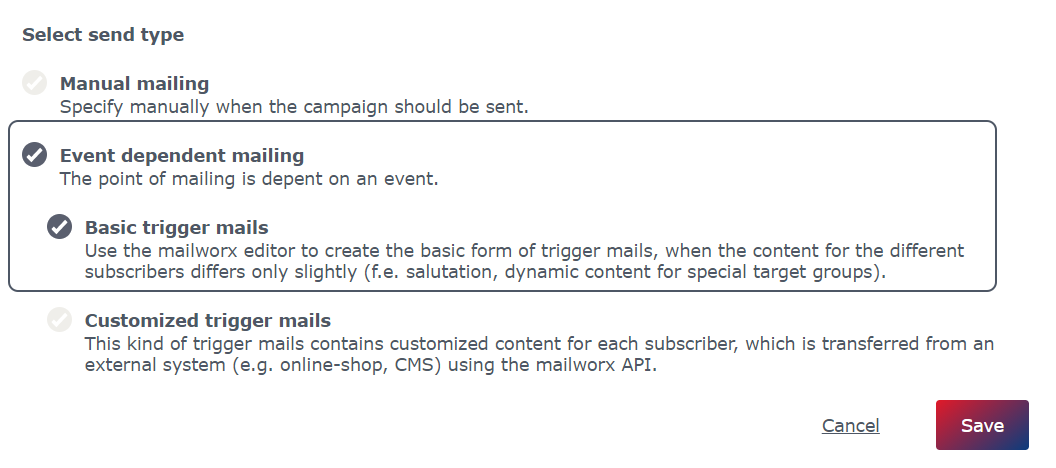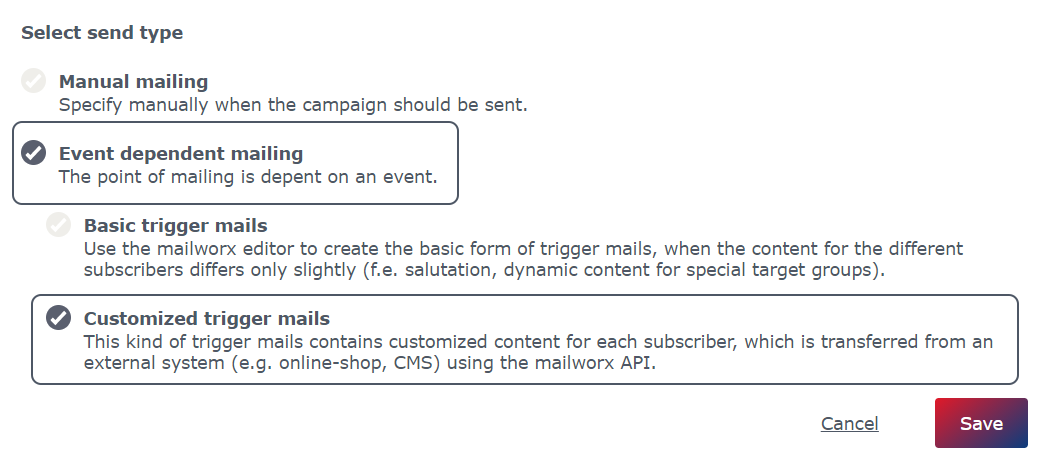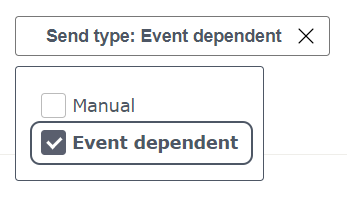Trigger mails & auto responder
with the eworx Marketing Suite
Without a doubt, trigger mails are the most efficient form of email marketing. They not only achieve above-average opening and click rates, they are also veritable sales drivers and an ideal item for maintaining customer relationships. You want to use trigger mails in your email marketing? Great decision!
With the eworx Marketing Suite you can either implement basic trigger mails (for example a welcome mailing) or customized trigger mails (for example order confirmations with product recommendations). In this whitepaper, we will focus on individualized trigger mails in combination with the mailworx API.
If your question hasn´t been answered in this whitepaper, please let us know. We´d gladly catch up on this.
What are trigger mails?
Trigger mails are event-based email campaigns that are triggered by a specific event and will be sent automatically at the specific time of action. That’s why they are so successful. Trigger mails in the eworx Marketing Suite are divided into two types: basic trigger mails and customized trigger mails.
What is the difference between basic and customized trigger mails?
Depending on how individual you want to adjust the campaign to your subscribers, we distinguish between basic and customized trigger mails.

Basic trigger mails
Basic trigger mails can be created directly in the campaign editor, as the content differs only slightly per subscriber (e.g. personalized salutation, dynamic content for special target groups, etc.).
- Auto responder after submitting a form
Send registration confirmations or welcome mailings, make new subscribers happy with your latest newsletter or send a series of information to new users. Use event dependent campaigns and workflows for these issues. - Date dependent trigger mails
With automated birthday messages or anniversary mailings, you are guaranteed to satisfy your customers. - Trigger mail by link-click
Reward the engagement of your subscribers. By clicking on a link, the reader signals interest in the topic. So what about a campaign with more information? In the link options, you can easily select the corresponding email.
Basic trigger mails are implemented by using the workflow editor or event dependent campaigns.
Customized trigger mails
Customized trigger mails contain individualized content per subscriber, which is transferred from a third-party system (such as an online shop) via the mailworx API directly into your mailing.
- Transaction mails from order to product evaluation
Online store owners not only simplify the order process with trigger mails, they also increase their sales through product recommendations or promotions customized to the buyer. Information about the shipment tracking or the possibilities for the evaluation of a product will increase the service additionally. - Booking information with travel tips from the target region
Tour operators awaken holiday anticipation and confidence in their service with personalized booking confirmations. Travel tips tailored to the destination and weather information at the time of travel are creating a real benefit for the customer. - Automated helpdesk tickets
Automated campaigns are great for your customer service. The support cases are recorded in a ticketing system. The customer receives status information about the open ticket, information about the processor and feedback options via trigger mails. - Relevant news feeds
You have a large assortment of different products or you run a blog with a variety of topics? Regularly provide your subscribers with information about new content that suite to their interests.
What are customized trigger mails used for in email marketing?
By the use of trigger mails, you create an extra value for your subscribers. Additionally, they feel appreciated and you build trust in your service. Professional trigger mails contain highly individualized content that can be derived from the shopping or booking behaviour. With the eworx Marketing Suite API, the required information from external systems can be used for your email marketing campaigns.
There are varieties of scenarios in which individualized trigger mails ensure that employees are relieved and customers are still getting the best service as possible. The online shop is a classic example. After the order is conducted, promptly the information that the order has been received can be sent to the customer. If one forgot to complete the transaction, a reminder flutters into the inbox. The package is sent and your customers know, of course, because they were notified by email. You can also use the chance to place related products or a product evaluation in an after buying mail.
We all know the prime example of successful trigger mails. However, there are many more possibilities:
- Booking information with travel tips of the destination
- Automated helpdesk tickets
- News feeds on interesting topics
- Job information tailored to qualifications
- Individualized reports
- etc.
What steps need to be taken to create a customized trigger mail?
Professional trigger mails with customized content require a little lead time, as you have to work with the mailworx API to transfer content from third-party systems. However, the benefit you gain justifies the initial effort. We will show you step by step, which measures must be taken to establish successful trigger mails.
Step 1: Prepare the trigger mail campaign in the eworx Marketing Suite
Create a new campaign using the campaign editor. This campaign declares the visual framework of the trigger mail and contains only content that is the same for all recipients.
Fulfil the following areas:
- Key campaign data (subject, sender, sender email address, etc.)
- Subscriber group
- Pre-header
- Personalized salutation and introductory text
Tip: Use personalization elements – e.g. [%mwtm:ordernumber%] or [%mwtm:productname%] – the values for these placeholders will come from the third-party system and are replaced by the customer-specific details. Be sure to use exactly the same field label that your developer hands over in the mailworx API.

Send type „Event dependent“
Select from the drop-down menu the send type „Event dependent“ in the area „Settings“ when creating a campaign. Now activate the option „Customized trigger mails“.

Campaigns that have been marked as event dependent – whether for creating basic or customized trigger mails – are listed in the campaign overview under „Event dependent“ and can be filtered by this characteristic.

Step 2: Tell your developer about your requirements
The following information is important for your developers, in order to successfully implement customized trigger mails. Answer the following questions in advances and pass the important information on to your developers.
- What content do I want to transfer from the external system?
- In which type of section should the content be transferred?
- Which data is displayed in the headline and which in the text area?
- Which link category has to be set? (e.g. resources, workshops, etc.)
Step 3: Connect the systems via the mailworx API
Now it’s the turn of your developers – they will make sure that your third-party system communicates smoothly with
the eworx Marketing Suite. Therefore, they have to use the mailworx API.
The developer programs an application that defines which values are transmitted and in which form they are displayed in the mailworx campaign. Afterwards, the application only have to be linked to the third party system so that the trigger mail logic and dispatch are triggered at the desired event (e.g. order, registration, etc.).
How do I evaluate trigger mails?
In the eworx Marketing Suite statistic overview, you first have to switch to the event dependent campaigns in the selection overview. Here you can see the statistic of all your basic and customized trigger mails.

Link categories
In the presentation of the statistics, you have the link categories that are displayed instead of the concrete links. If you have a large assortment depth, you will have a better overview if you define certain product groups as link categories. However, you can also give your own value for each product.